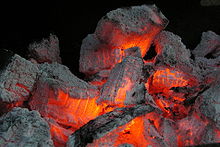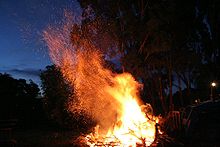- Ember
-
For the wireless networking chip company, see Ember (company). For the book series by Jeanne DuPrau, see The City of Ember. For specific fasting days within Western Christian churches, see Ember days. For other uses, see Embers (disambiguation).Embers of coal

Embers are the glowing, hot coals made of greatly heated wood, coal, or other carbon-based material that remain after, or sometimes precede a fire. Embers can glow very hot, sometimes as hot as the fire which created them. They radiate a substantial amount of heat long after the fire has been extinguished, and if not taken care of properly can rekindle a fire that is thought to be completely extinguished and can pose a fire hazard. In order to avoid the danger of accidentally spreading a fire, many campers pour water on the embers or cover them in dirt.
They are often used for cooking, such as in charcoal barbecues. This is because embers radiate a more constant form of heat, as opposed to an open fire which is constantly changing along with the heat it radiates.
An ember is usually formed when a fire has only partially burnt a piece of fuel, and there is still usable chemical energy in that piece of fuel. Often this happens because the usable chemical energy is so deep into the center that air (chemically O2) does not reach it, therefore not causing combustion (carbon-based fuel + O2 → CO2 + H2O + C + other chemicals involved). The reason that it continues to stay hot and does not lose its thermal energy quickly is because combustion is still happening at a miniature scale. The small yellow, orange and red lights often seen among the embers are actually combustion. There just is not enough combustion happening at one time to create a flame. By the time embers are completely 'burned through', almost all of it is pure carbon will have loose physical bonds, which is why they crumble with the slightest touch. At that point they are normally called ashes.
Embers play a large role in forest fires. Since embers are typically burnt leaves and thus small and light, they can be blown away by the wind. During a large fire, with the right wind conditions, embers can be blown far ahead of the fire front, starting spot fires hundreds of metres away. One of the initial stages of defending against a bushfire is dubbed the "ember attack", in which embers will bombard the house, starting small fires in wooden structures.[1]
References
- ^ "Protect Your Property - Make your property safe from bushfire". Australian Country Fire Authority. Archived from the original on 2008-07-22. http://web.archive.org/web/20080722075835/http://www.cfa.vic.gov.au/residents/living/protectyourproperty.htm. Retrieved 2008-07-25.
See also
- Spark, an airborne ember
Categories:
Wikimedia Foundation. 2010.


